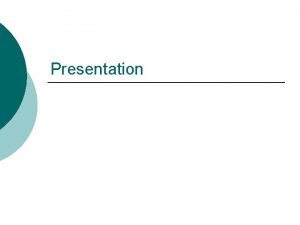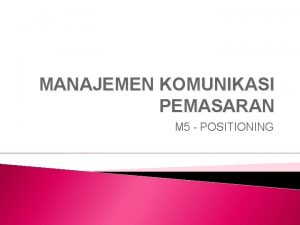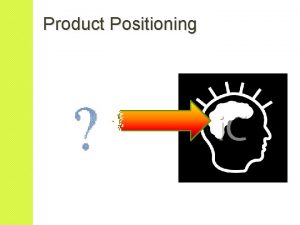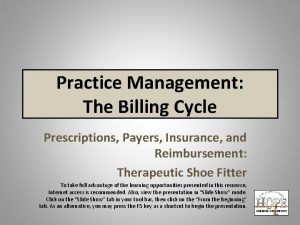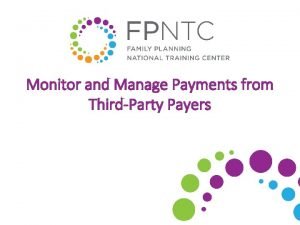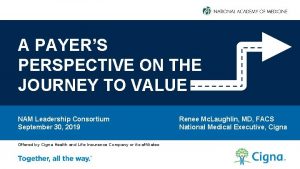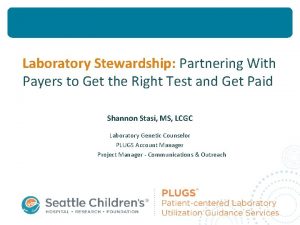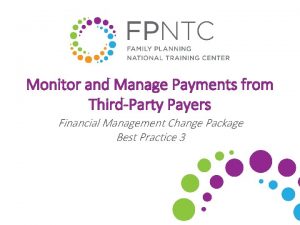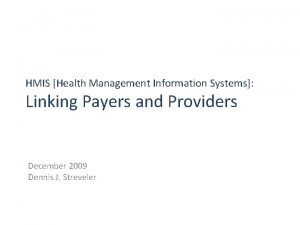Positioning your Practice for Success with Payers Moderator









































- Slides: 41

Positioning your Practice for Success with Payers Moderator: Norman Vinn, DO President/Medical Director of Housecall Doctors Medical Group, Inc. Panelists: Christopher Day, MPH, MBA Julia Jung, CPA Alan Kronhaus, MD Steven Phillips, MD Chris Van Antwerp

Faculty Disclosures • Day – Kindred House Calls – Employee and Stock Holder • Jung – no relevant disclosures • Kronhaus – Doctors Making Housecalls, LLC – Owner, Co-Founder & CEO • Phillips – FEMR Group – Founding Member • Van Antwerp – US Medical Management – Employee • Vinn – Medical Director – Housecall Doctors Medical Group, Inc. ; CEO & Shareholder – The Residentialist Group, Inc.

Objectives • Distinguish between the different financial models. • Use the information presented to improve their practice's financial standing.

Hierarchical Condition Categories and Quality Measurements Steven L. Phillips, MD Medical Director Sanford Center for Aging Professor of Clinical Internal Medicine University of Nevada School of Medicine

In 2004 the Centers for Medicare and Medicaid Services (CMS) implemented the Hierarchical Condition Categories (HCC) model to adjust capitation payment to private health plans for the health expenditure of their enrollees. The CMS Risk Adjustment Model measures the disease burden that includes 79 categories which are correlated to diagnosis codes. This model is accumulative, meaning that a patient can have more than one HCC category assigned to them. Some categories override other categories leading to the hierarchy.

Available Health Plan Data • Demographic Information • Historic Information • Billing Information • Pharmacy Information (Part D) • Diagnostic Information

Low Hanging Fruit • HCCs present in a previous year but not submitted during the current year • Requires a prompt for continued presence of medical conditions to support verification, documentation, coding and claims submission • These conditions represent lost revenue and belongs to the “undercoded” category

Suspect Conditions • Possible existence of condition present based on the medications identified through Part D • Possible existence of condition present based on billing data for diagnostic or procedural CPT submission (i. e. Hb. A 1 C) • Requires verification, documentation, coding and claims submission

Data Validation • Risk Adjusted Data Validation (RADV) introduced in 2013 within Medicare Advantage Plans (MAP) • Performed nationwide through Recovery Audit Contractor (RAC) programs • Based directly on the quality of the documentation and coding of individual records

Failing RADV Audits • Repayment of revenue from over submitted coding • Extrapolation of the findings across the entire plan • Possibility of more intense scrutiny • Generally due to under documentation in that condition actually does exist

Internal Data Validation Upside • Opportunity to reconcile overcode submissions and avoid penalties • Identification of undercode submissions which is typically a 2 to 1 ratio • Data validation is also important in meeting quality measures in addition to the role of data analytics

The FEMR Philosophy • F – Familiarize • E – Educate • M – Manage • R – Re. Evaluate

Familiarize • Analyze and Evaluate • Discover Gaps in Care, Capture, and Efficiency • Organization • Site • Provider • Patient

Educate • Gaps of Care Measures • Physician Quality Reporting System (PQRS) • Clinical Quality Measures (CQM) • Accountable Care Organization (ACO) • Gaps of Capture • Hierarchical Condition Categories (HCC) • Burden of Illness • Gaps of Efficiency • Perform at the top of one’s scope

Manage • Team approach • Proactive Tools • Showing gaps • Identifying level of outreach • Dashboards/Reports • Inform team members of necessity

Re. Evaluate • Are the strategies working? • Change APM level? • Do you need/want to drop down? If so why? • Do you want to “graduate” to a higher level? • Are you ready? • Follow the FEMR Philosophy

Geriatric Specialty Care (2 D) • Familiarize • Analyzed data to better understand which Measures to report • Educate • Gaps of Care – Consisted of the 9 measures we report against • Tools – Created reminders to help providers and staff • Manage • Real time Dashboards/Reports • Re. Evaluate • After three years of successful reporting we have decided to join an ACO

ACO/IAH (3 A) • ACO 30, 188 members • IAH 4, 977 members • Other 20, 771

ACO/IAH (3 A)

Health Information Exchange • Helps with Closing • Gaps in Care • Gaps in Capture • Gaps in Efficiency • Disparate EMR’s • Real Time Alerts

Chronic Conditions • Unique Patients seen 2016 – 908 • CCM • January 130 • February 158 • March 196

Successful Negotiations Julia Jung, CPA

Successful Negotiations With Payors KNOW YOUR VALUE

Successful Negotiations With Payors Phase One: PLAN: • Advance Preparation……. Phase two: PRESENTAION: • • • Audience Approach Failure Success Debrief

Successful Negotiations With Payors Advance Preparation: Positioning your practice as Market Leader • • • Know Your Value Know your operating costs Know your capacity Know your scalability Know your industry Know your competitors Know your goal Know contracting terminology and legal risk Know your Payor Organization Rehearse

Successful Negotiations With Payors ADVANCE PREPARATION: Know Your Value Care Model Practitioner Visits Urgent visits Triage Coordination of Care Ancillary Services Call Experience Data Outcomes IP Reduction ED Reduction HCC Lift HEDIS Improvement Overall Cost Reduction Patient Satisfaction

Successful Negotiations With Payors ADVANCE PREPARATION: Know Your Operations • Operating Costs • Current Capacity: Administrations/Clinical metrics • Scalability

Successful Negotiations With Payors ADVANCE PREPARATION: Know Your Industry What services are pervasive? • HEDIS • HCC • Assessments • Utilization Management • Value Based Contracting: Pay for Performance

Successful Negotiations With Payors ADVANCE PREPARATION: Know Your Competitors Know your market competitors relative to your operations: • Size • Scope of services • Managed Care Contracts • Value Based • Outcomes

Successful Negotiations With Payors ADVANCE PREPARATION: Know Your Goals Defined goals: • Medicare FFs @ 100% • Shared Savings • PMPM • Full Risk • Pilot • Program • Determine “NLMW”

Successful Negotiations With Payors ADVANCE PREPARATION: Know Your Contracting Terminology and Legal Risk – TOP 10 1. Credentialing: Group/Supervising Practitioner 2. CPT: Be specific, include attachment, detail CPO/CCM 3. Fee Schedule and multiple; MD/NP/PA 4. Who determines medical necessity? Where are the criteria posted? 5. Prior Authorizations/Patient eligibility – Web based –Transaction number given? 6. Provision of Services (Need to modify processes and procedures – professional liability, JOC, 24/7, documentation requirement) 7. Timing of Claim Submittal/Payment – remediation process 8. A/R – interest or delayed reimbursement - advance 9. Unilateral unlimited over payment recovery (audits) 10. Termination notice requirements/Automatic contract renewal/ Exclusive contracts

Successful Negotiations With Payors ADVANCE PREPARATION: Know Your Payor Organization Formulate your contract in terms of Payor needs • Know their products • Know their market position • Know their Agenda Often times learned during presentation – prepare to be nimble

Successful Negotiations With Payors ADVANCE PREPARATION: Rehearse • Opening • Discussion points • Close Rehearse a response for opposition to each discussion point Rehearse redirection – Limited time - ABC Prepare for trial!

Successful Negotiations With Payors PRESENTATION: Audience Start Where You Can - Advance Market CEO; CMO, CFO, COO, VP of Medical Affairs, VP of Operations, VP Network, Provider Relations, Clinical Liaison Audience: Review Professional Background Your organization: Create a contracting team to include CEO, CMO, Operations and legal Collateral

Successful Negotiations With Payors PRESENTATION: Approach • Set win-win tone: Ambitious, confident, determined and positive • Emphasize aligned objectives • Open channels of communications • Use questions and hypothetical to learn needs and potential opposition • Brevity – Listen! • Adjust – Think on Your Feet • ABC

Successful Negotiations With Payors PRESENTATION: Failure • Recognize and gracefully accept failure when it comes to you • Ensure you keep the “Door” open • Do not accept a Bad Deal • Debrief: • Timing • Prepared • Me – Stubborn • What went wrong • Adjust for the future

Successful Negotiations With Payors PRESENTATION: Determining Success • Achieved “Can’t leave meeting without” • Meeting intelligence altered current goal • Defined next steps • Debrief: • What went well • What needs improvement • Adjust for the future

Successful Negotiations With Payors KNOW YOUR VALUE

Fee-for-Service Alan Kronhaus, MD

You Can Be Successful In Straight Fee-For-Service! ü Don’t leave $$ on the table • Document everything you do • Documentation must support LOS • Know how to bill based on time Total time; time in counseling & coordination of care; what you did in counseling & coordination ü Know how to bill for phone time ü Know how to bill for certs/recerts & CCM

Panel Discussion Go to: 2 Shoesapp. com/AAHCM 2016 1. Click on the session you are in 2. Ask and vote on questions
 Your child's success or lack of success
Your child's success or lack of success Your child's success or lack of success
Your child's success or lack of success Moderator variable in research example
Moderator variable in research example Tugas moderator adalah
Tugas moderator adalah Classification of power plant
Classification of power plant Moderator examples
Moderator examples Regulator moderator war
Regulator moderator war Mediator vs. moderator variable
Mediator vs. moderator variable Moderator examples
Moderator examples Mediator vs moderator
Mediator vs moderator Brainly.ro
Brainly.ro Moderator show
Moderator show Umur andira tiktok
Umur andira tiktok Nsnhe,f
Nsnhe,f That's all for my presentation
That's all for my presentation Powercfg /srumutil
Powercfg /srumutil Gestructureerde observatie
Gestructureerde observatie Moderator
Moderator Liking scale 1-5
Liking scale 1-5 Cara moderator
Cara moderator Moderator script for webinar sample
Moderator script for webinar sample Moderator tom
Moderator tom Constant moderator
Constant moderator Continuous moderator
Continuous moderator Give us your hungry your tired your poor
Give us your hungry your tired your poor Chapter 1 preparing your path to success
Chapter 1 preparing your path to success Iso 22301 utbildning
Iso 22301 utbildning Typiska novell drag
Typiska novell drag Nationell inriktning för artificiell intelligens
Nationell inriktning för artificiell intelligens Returpilarna
Returpilarna Shingelfrisyren
Shingelfrisyren En lathund för arbete med kontinuitetshantering
En lathund för arbete med kontinuitetshantering Underlag för särskild löneskatt på pensionskostnader
Underlag för särskild löneskatt på pensionskostnader Tidbok för yrkesförare
Tidbok för yrkesförare A gastrica
A gastrica Vad är densitet
Vad är densitet Datorkunskap för nybörjare
Datorkunskap för nybörjare Boverket ka
Boverket ka Debattartikel struktur
Debattartikel struktur Autokratiskt ledarskap
Autokratiskt ledarskap Nyckelkompetenser för livslångt lärande
Nyckelkompetenser för livslångt lärande Påbyggnader för flakfordon
Påbyggnader för flakfordon














